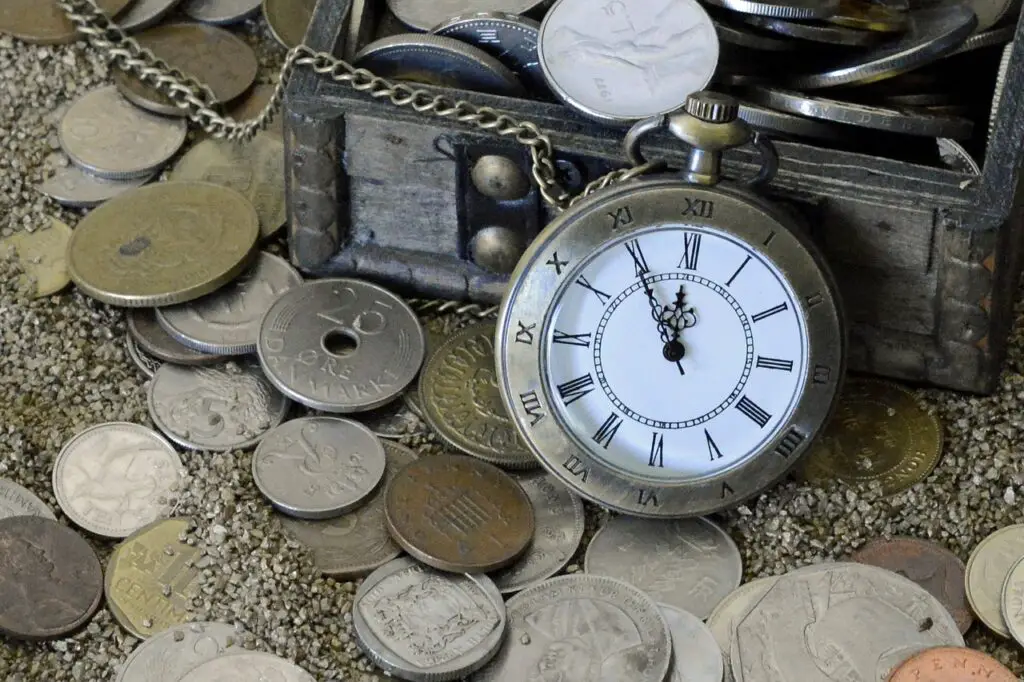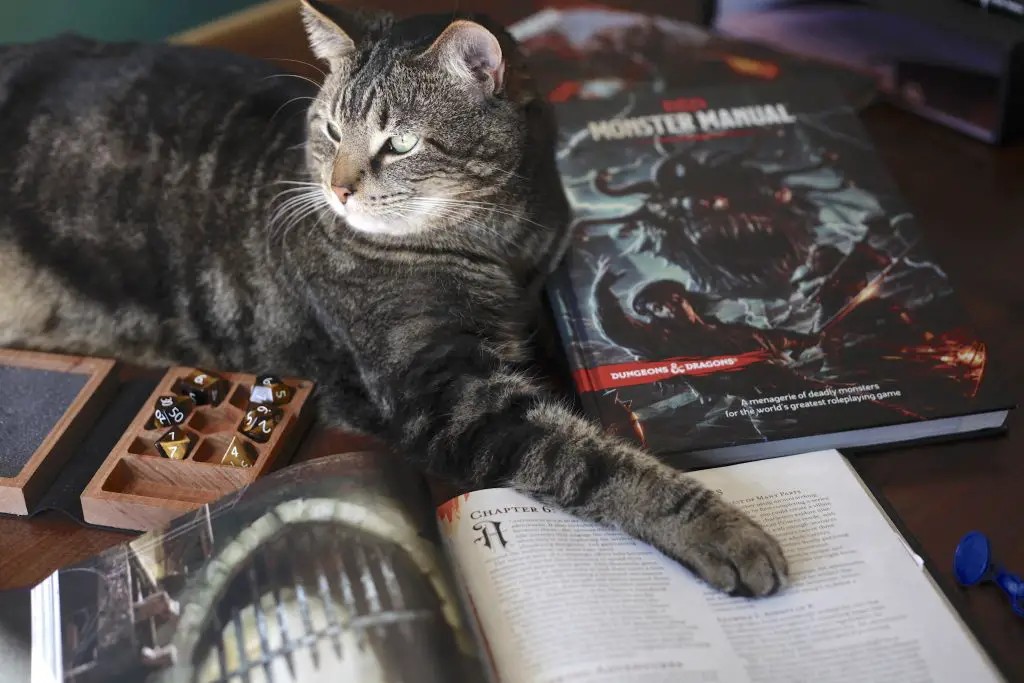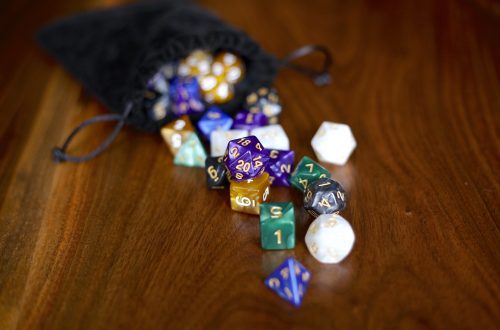How to Run a D&D Heist for Players that Love to Steal
Hey there! This website does contain affiliate links. If you purchase something through this page, Cats and Dice may earn a share of sales from the link. Learn more.
Heists offer a thrilling departure from a standard Dungeons and Dragons tabletop game. While standard D&D games are loads of fun with dungeon crawls, epic battles and exploration, and the promise of treasure, a D&D heist offer a unique twist on the fantasy roleplaying game. Let’s dive into what makes these adventures unique and how to craft and run D&D heists for Dungeon Masters and players alike.
What makes a D&D heist different from regular D&D?
Before we talk about creating and running a Dungeons and Dragons heist, let’s talk about what a D&D heist is and isn’t and how it differs from running a standard D&D dungeon crawl.
What is a D&D Heist?
A heist is a robbery that typically involves a plan, teamwork, and often some daring elements. The target of a heist is usually something valuable, like money, jewels, or art. In Dungeons and Dragons, heists can also include magical items or lore specific artifacts. Heists can be exciting and suspenseful because they involve risk and clever planning.
It’s important to note that D&D heists are not the same as more traditional D&D gameplay formats, though, primarily dungeon crawls.
D&D Heists versus Dungeon Crawls
This element of planning, or prior knowledge, is a key part of what makes a D&D heist different from a dungeon crawl. In a dungeon crawl, players are exploring the area for the first time with little to no prior knowledge. They don’t necessarily have a goal in mind or their goal doesn’t necessarily require finesse to solve. Although on a meta level players probably know that there are valuable items within any dungeon, a heist involves a specific and known item that the player characters, or PCs, must retrieve but will be difficult to do so.
D&D heists generally require a different skill set from the players than dungeon crawls. While dungeon crawls often involve strong fighting abilities, interactions with NPCs in heists often involve Charisma checks such as Persuasion or Deception. Stealth and Sleight of Hand are often required, too. Heists normally require these skills with non-playable characters, or NPCs, instead of fighting for three reasons:
- It may hurt the mission rather than help to kill an encountered NPC
- The NPC might be helpful towards the heist
- The NPC might be part of the heist in some way
With this basic understanding of a D&D heist laid out, it’s time to outline and build out the elements of a D&D heist to run one for your players or to plan out your heist as a player.

The Elements of a D&D Heist
D&D heists involve six basic elements:
- The Target
- The Setting
- The Crew
- The Plan
- The Execution
- The Escape
Let’s dig into each of these step by step.
#1 The Target
The target, which can also be thought of as the object, is the item to be taken during the heist. The most important consideration when choosing a target object for the players to steal is determining why it’s important. It can be as simple as an NPC hiring the players to steal the object or as vital as being part of a larger campaign.
No matter why the players are stealing the target object, the object should be considered valuable enough by someone to be worth protecting. The greater known value of the object, the more heavily protected the item would be.
Alternatively, consider the option that the heist will involve leaving an object behind rather than taking one. This can include magical objects that will let players spy on someone, dummy objects in place of the real item, or false documents to frame an NPC.
#2 The Setting
Because the protection of the target object is just as important as the target itself, the setting is an important part of running any D&D heist. Players will often want to scope out the area beforehand in order to create The Plan, which we’ll talk about more in Step 4.
Make sure to have a strong layout of your heist location and, more importantly, a strong understanding of what the players can actually learn before the actual heist. For example, if they scope out the location at a particular time of day, make sure the comings and goings of NPCs match that time of day. This is where it’s important to consider the object in question. A more known valuable item might be protected by a museum, which will have a very different set of protections than a lesser known item protected by an eccentric billionaire in their mansion.
Additionally, if the player characters want to buy items to assist them with the heist, make sure the items would conceivably be available at their location. Don’t block them from buying glass cutters just because that’ll make it easier for them, but perhaps they could be marked up or considered suspicious if they’re in a large city.
#3 The Crew
The crew will certainly involve your player characters, but it may involve NPCs as well. As a general rule, it’s better to not include NPCs in the actual heist crew unless your players specifically ask an NPC to be involved. They might do this because an NPC has a skill set they can use, such as lockpicking or prior knowledge about the setting. They might also invite an NPC just because they like them. No matter what, it’s not a problem for players to invite NPCs, but it’s important to keep in mind that the heist is for the players and to let the players take charge of the situation.
Then, as a DM, you will want to take special consideration for your player’s capabilities. For example, if any of your players’ characters are capable of flying or casting the Fly spell, then they’ll be able to retrieve a suspended item or bypass floor traps pretty easily. Sometimes it’s good to include things that make the players feel accomplished, but make sure to also include things that are actual traps for them, too.
This is especially important when it comes to locks. Heists are full of locks, and because of that, it is wise to always prepare for multiple ways that players can bypass any lock such as breaking down doors or finding another entrance. Not only will this make the game more interesting through variety that speak to different PC skill sets, it will also act as a failsafe in case the players have terrible rolls.
#4 The Plan
The plan for how to execute the heist will largely be up to the players. However, Dungeon Masters can sprinkle in recommendations and information as the players create their plan. For example, if their plan is to use bolt cutters to break through a fence, an NPC merchant could casually mention that the cutters only work for certain kinds of metal, which would prompt the players to investigate the fence in question.
#5 The Execution
Much like the plan, the actual execution of the plan will largely be determined by players and dice rolls. A Dungeon Master might want to have ideas for disaster or aid prepared just in case the players’ plan goes too well or too horribly, though. If everything is running too smoothly for it to be entertaining, perhaps an unexpected NPC shows up at an inopportune time or a magical security system was installed against the players’ knowledge. The general rule of thumb is that it’s fun if the players are successful but it’s even more fun if it’s challenging, too.
#6 The Escape
Oftentimes in dungeons, once the player characters get in, it’s not too difficult to then get back out as long as they follow routes they know. Heists often will work differently, though, because getting out is usually just as hard or harder than getting in. The escape also includes offloading the item in question. Even if the player characters were tasked with retrieving the item for an NPC, that doesn’t mean there couldn’t be repercussions if they’re seen at the scene of the crime. Even getting the item to the NPC could pose challenges. Or, if the players stole the item for their own purposes, there could be extra repercussions there.
Complications and Mechanics During a D&D Heist
Complications for D&D Heists
No matter how much planning the PCs do or how good their dice rolls are, half the fun of a heist is the things that go wrong in their attempts. As mentioned in Step 5, make sure to plan for these complications to surprise and challenge your players.
Possible complications during your D&D heist could include:
- A dummy item
- A moved item
- A new security system (such as a new guard rotation)
- Another competing thief team (expected or unexpected)
- An unexpected event at the location (natural disaster, explosions, etc.)
- The item is cursed (knowingly or unknowingly)
- A invisible magical barrier that prevents spells
Unique Mechanics for a D&D Heist
Additionally, you can add unique mechanics to your game specifically for the heist. Here are a few good ones and why you might want to add them.
Flashbacks
Calling for a flashback when in a tough spot allows for a balance between planning an actual play rather than separating the heist into two separate chunks. By calling for a flashback, the players can retroactively prepare for a situation before actually tackling it. This requires some improvisation on the DMs part since the players shouldn’t be able to come up with something that automatically works just because it’s clever. However, it can be as simple as setting a high DC for a roll. You can learn more about the flashback mechanic from DM David.
Traps and Puzzles
Although dungeon crawls and other D&D games often feature traps and puzzles, you will want more subtle ones for your D&D heist game. You can use a resource like The Game Master’s Book of Traps, Puzzles, and Dungeons for ideas. There are pre-made traps designed to be disruptive, painful, or even deadly, along with a random generator for traps and puzzles.
Competition
If a target object for a heist is well known or for some reason in high demand in a D&D campaign, it’s very possible that the player characters aren’t the only ones after it. Other NPCs might be after the same item for some reason, either to or against the players’ knowledge. This competition could add an extra layer of needed mechanics to the heist, either through fighting the competitors, Charisma checks against them, and so on.
Time
A unique element of D&D heists can be a time component. Whether the NPC guarding over the object in question is due to return within a half an hour or disabling a magic spell sets off some sort of alarm, it’s not likely that players will be able to get the object in question at their leisure. This can lead to several different mechanic options. Each player can take a turn as if it were combat to slow down time or a literal timer can be set up as the heist goes along.

Where to Get Inspiration for Your D&D Heist
If you’re looking for more inspiration for running D&D heists, there are plenty of other kinds of media you can reference, both tabletop gaming related and otherwise.
Tabletop RPG Heist Modules
If homebrewing a game isn’t your thing, you can find premade adventures for heists or prebuilt components for them. You can insert the premade adventures into an existing campaign or play them on their own.
- Here’s to Crime: A Guide to Capers and Heists
- The Villa Heist
- Diamond Heist
- The Harpers’s Heist
- The Heist at Nimressa
- A Spot of Payback
- Handful of Heists
Other Tabletop RPGs
There are lots of tabletop roleplaying games that are well designed for heists already. Either playing these roleplaying games or watching live or recorded streams of them may give you lots of information either for creating a D&D heist or for executing your D&D heist if you’re a player. Some good games include:
Heist Books
Dungeons and Dragons was created as a means to play out your favorite fantasy books, so getting inspiration for your D&D game through books is a great way to go. There are many books out there for fantasy heists, but these will get you started.
- The Lies of Locke Lamora
- Six of Crows
- Nocturna
- The Feather Thief
- Stealing Rembrandts
- Mistborn: The Final Empire
If you’d prefer to enjoy these books as audio books, you can try out an Audible subscription.
Heist Movies
To visually see how a heist might play out, you can stream some heist movies for ideas for your D&D heist game.
Time to Steal!
As you can see, there are great reasons to run a D&D heist for your Dungeons and Dragons campaign and many ways to do it. You now know what a D&D heist is, how it differs from a standard dungeon crawl, the six elements of a D&D heist, and how to complicate your heists. There are plenty of heist games, books, and movies to inspire your D&D heist as well. So what are you waiting for? It’s time to play or run your D&D heist!
Hi there! I’m Kristen. I’m a game writer, a Dungeon Master, and like you, I love tabletop games. Visit our About page to learn more about me.
I wrote this Cats and Dice article to help you enjoy gaming even more. Did it help? If so, our kitties (and our site) would be grateful for a little gift through Ko-Fi.


